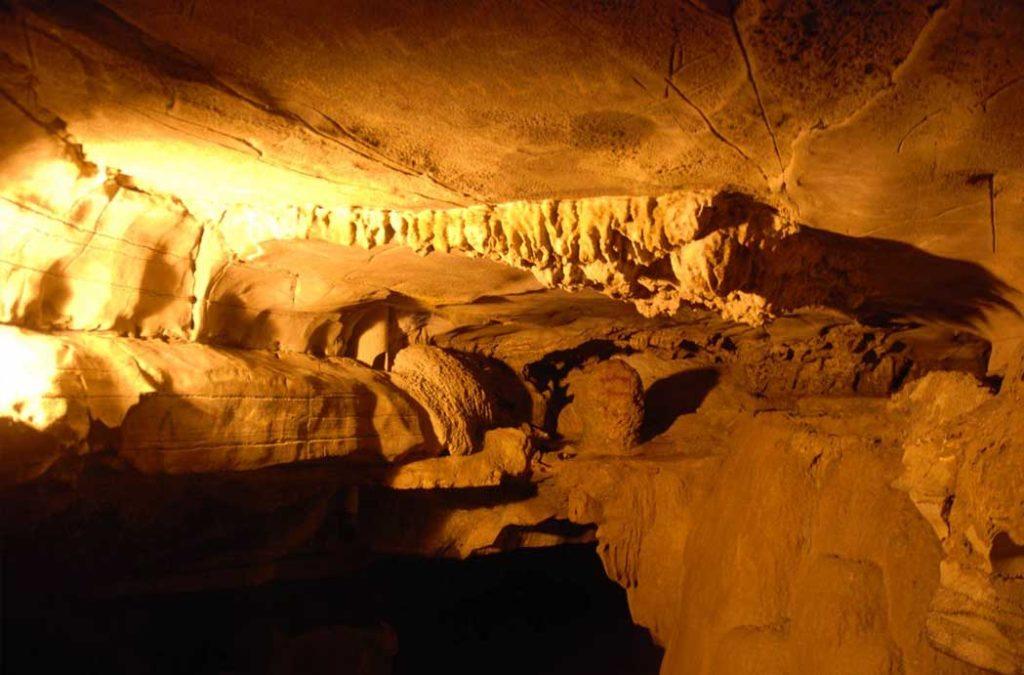A Journey Beneath the Earth
Imagine squeezing through a narrow limestone passage, your flashlight catching glints of ancient stalactites, as the cool, damp air wraps around you like a secret. Caving in India isn’t just an adventure—it’s a plunge into Earth’s hidden universe, where geological wonders, history, and mystery collide. From Meghalaya’s labyrinthine caves to Andhra Pradesh’s ancient formations, this guide explores how spelunking reveals India’s subterranean marvels, blending adrenaline with awe.
What is Caving and Why India?
Understanding Caving
Caving, or spelunking, involves exploring natural cave systems, navigating tunnels, and marveling at geological formations like stalactites. In India, it’s a growing adventure sport, combining physical challenge with scientific discovery. Meghalaya alone hosts over 1,500 caves, many unexplored, making it a global caving hotspot.
India’s Unique Cave Systems
India’s diverse geology—limestone in Meghalaya, sandstone in Karnataka, basalt in Maharashtra—creates stunning cave networks. These caves hold fossils, ancient art, and unique ecosystems, offering a glimpse into millions of years of Earth’s history. They’re portals to a world untouched by time.
Meghalaya: The Caving Capital
Meghalaya, dubbed India’s “Caving Capital,” boasts some of South Asia’s longest and deepest caves, like Krem Liat Prah. Its limestone formations and underground rivers draw adventurers worldwide. The state’s 1,500+ caves make it a must-visit for spelunkers.
Other Regions to Explore
Beyond Meghalaya, Andhra Pradesh’s Belum Caves and Karnataka’s Yana Caves offer distinct experiences. From Buddhist relics to karst landscapes, these regions showcase India’s geological diversity. Each cave tells a unique story of nature and history.
Top Caves to Explore in India
Mawsmai Cave, Meghalaya
Located near Cherrapunji, Mawsmai Cave is perfect for beginners, with lit limestone passages showcasing stunning stalactites. Its lush surroundings add charm, making it a tourist favorite. A short visit feels like stepping into a natural cathedral.
Krem Liat Prah, Meghalaya
India’s longest cave, stretching over 34 kilometers, Krem Liat Prah in Jaintia Hills is a spelunker’s dream. Its vast chambers and underground rivers challenge even seasoned cavers. This unexplored marvel is a bucket-list adventure.
Belum Caves, Andhra Pradesh
The second-largest cave system in India, Belum Caves features 3.2 kilometers of passages formed by the ancient Chitravathi River. Buddhist relics and unique fauna make it a historical and ecological gem. It’s a weekend getaway from Bengaluru.
Borra Caves, Andhra Pradesh
Nestled in the Ananthagiri Hills, Borra Caves plunge 80 meters deep, with dramatic limestone formations resembling mythological figures. A small Shiva temple inside adds spiritual allure. It’s a visual spectacle for all adventurers.
Edakkal Caves, Kerala
In Wayanad, Edakkal Caves date back to 6000 BCE, with Neolithic carvings and a nearby grave site. These natural shelters blend history with adventure. A short trek from Kozhikode leads to this ancient wonder.
Yana Caves, Karnataka
Yana Caves, in the Western Ghats, feature two massive karst limestone outcrops. A short hike from Gokarna reveals a holy site rich in biodiversity. The caves’ serene vibe captivates nature lovers and pilgrims alike.
Top Caves Table
| Cave Name | Location | Length/Depth | Key Features | Best For |
|---|---|---|---|---|
| Mawsmai Cave | Meghalaya | 150 m | Lit limestone, stalactites | Beginners, tourists |
| Krem Liat Prah | Meghalaya | 34 km | Underground rivers, vast chambers | Experienced cavers |
| Belum Caves | Andhra Pradesh | 3.2 km | Buddhist relics, unique fauna | History buffs, adventurers |
| Borra Caves | Andhra Pradesh | 80 m deep | Limestone formations, Shiva temple | Families, nature lovers |
| Edakkal Caves | Kerala | 100 m | Neolithic carvings, grave site | History enthusiasts |
| Yana Caves | Karnataka | 500 m | Karst outcrops, biodiversity | Hikers, spiritual seekers |
The Mental and Physical Benefits of Caving
Boosting Mental Resilience
Caving challenges your mind, requiring focus and problem-solving in tight, dark spaces. A 2023 study in Journal of Adventure Education found caving reduces stress by 15% through immersive focus. It’s like meditation with a flashlight.
Enhancing Physical Fitness
Navigating caves builds strength, agility, and endurance. Crawling, climbing, and wading burn 400–600 calories per hour, per a 2022 Sports Medicine report. It’s a full-body workout disguised as adventure.
Connecting with Nature
Caving immerses you in Earth’s raw beauty, fostering mindfulness. The silence of a cave, broken only by dripping water, grounds you in the moment. It’s a humbling reminder of nature’s vast timeline.
A Personal Caving Adventure
Last summer, I joined a guided tour to Mawsmai Cave in Meghalaya. As I squeezed through a narrow passage, my heart raced, but the sight of glittering stalactites felt like discovering a secret galaxy. Our guide shared tales of ancient explorers, and I left feeling like I’d touched the universe’s edge. That thrill keeps me hooked on caving.
How to Start Caving in India
Choose the Right Cave
Beginners should start with accessible caves like Mawsmai or Borra, which require minimal gear. Experienced cavers can tackle Krem Liat Prah with guides. Match your skill level to avoid overwhelm.
Essential Gear
- Helmet with Headlamp: Protects and lights your way. Petzl
- Sturdy Boots: Rubber or hiking boots for grip. Salomon
- Protective Clothing: Waterproof suits and gloves for wet caves.
- Rope and Harness: For advanced caves like Krem Liat Prah.
Join Guided Tours
Book with reputable operators like Thrillophilia or Meghalaya Adventurers’ Association ([email protected]). Guides ensure safety and share geological insights. Tours range from $20–$100 per person.
Best Time to Cave
Visit November to March for dry conditions, especially in Meghalaya, where monsoons flood caves. Check Meghalaya Tourism for seasonal updates. Plan ahead to avoid closures.
Comparing Caving Experiences
Beginner vs. Advanced Caving
Beginner caves like Mawsmai are lit and short, requiring no special skills. Advanced caves like Krem Liat Prah involve swimming, climbing, and technical gear, suited for thrill-seekers. Beginners prioritize ease, while pros chase challenge.
Solo vs. Group Caving
Solo caving is risky and not recommended; groups with guides ensure safety and camaraderie. A 2024 Adventure Tourism study found group caving boosts social bonds by 20%. Groups are ideal for all skill levels.
Comparison Table: Caving Experiences
| Type | Skill Level | Gear Needed | Safety | Best For |
|---|---|---|---|---|
| Beginner | None | Basic (helmet, boots) | High | Families, first-timers |
| Advanced | Experienced | Technical (ropes) | Moderate | Thrill-seekers, experts |
| Solo | High | Full kit | Low | Not recommended |
| Group | Any | Varies | High | Social adventurers |
Pros and Cons of Caving in India
Pros
- Unlocks geological wonders like stalactites and fossils
- Boosts mental focus and physical fitness
- Offers unique ecosystems, like cavefish in Siju Cave
- Blends adventure with history and spirituality
- Accessible for beginners and experts alike
Cons
- Risk of injury in advanced caves
- Monsoon closures limit access
- Claustrophobia can be a barrier
- High costs for gear and guided tours
- Fragile ecosystems require careful navigation
People Also Ask (PAA)
What is caving in India like?
Caving in India involves exploring limestone or sandstone caves with stalactites, underground rivers, and fossils. Meghalaya’s caves, like Krem Liat Prah, are world-class, offering adventure and history. Guided tours make it accessible for all.
Where are the best caves in India?
Meghalaya’s Mawsmai and Krem Liat Prah, Andhra Pradesh’s Belum and Borra, and Kerala’s Edakkal are top picks. Each offers unique formations and historical significance. Meghalaya is the caving capital with over 1,500 caves.
Is caving in India safe?
With proper gear and guides, caving is safe, especially in tourist-friendly caves like Mawsmai. Advanced caves require experience due to risks like flooding or tight passages. Always join guided tours for safety.
What equipment do I need for caving?
Basic caving requires a helmet, headlamp, sturdy boots, and gloves. Advanced caves need ropes, harnesses, and wetsuits. Check Petzl for quality gear suited for India’s caves.
FAQ Section
What makes India’s caves unique?
India’s caves blend geological marvels, like stalactites, with historical artifacts, like Edakkal’s carvings. Meghalaya’s 1,500+ caves and unique ecosystems make them globally significant. They’re portals to Earth’s past.
How do I prepare for caving in India?
Start with beginner caves, wear sturdy boots and a helmet, and book a guided tour via Thrillophilia. Train for endurance and check weather conditions to avoid monsoon risks.
Are India’s caves suitable for beginners?
Yes, caves like Mawsmai and Borra are lit and accessible, requiring no prior experience. Guided tours ensure safety and provide insights. Start here before tackling advanced systems like Krem Liat Prah.
Can caving benefit mental health?
Caving reduces stress by 15% through focused exploration, per 2023 studies. It fosters mindfulness and boosts confidence by overcoming challenges. The serene cave environment calms the mind.
Where can I book caving tours in India?
Book through Thrillophilia or Meghalaya Tourism for guided tours. Local operators like Meghalaya Adventurers’ Association offer expert-led expeditions starting at $20.
Tips for Caving in India
- Pack Light: Carry a flashlight, water, and snacks. Amazon has compact gear.
- Go Guided: Book with Thrillophilia for safe, informative tours.
- Respect Nature: Avoid touching stalactites to preserve delicate formations.
- Check Weather: Avoid monsoon season (June–October) for safety.
- Train Up: Build stamina with hikes before tackling advanced caves.
Conclusion: Discover India’s Underground Universe
Caving in India is like stepping into a hidden cosmos, where stalactites gleam like stars and underground rivers whisper ancient tales. From Meghalaya’s Krem Liat Prah to Kerala’s Edakkal Caves, each site offers adventure, history, and awe. Grab a helmet, book a tour with Meghalaya Tourism, and dive into Earth’s marvels. Your next great story waits beneath the surface.




